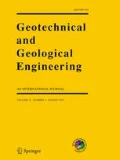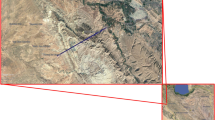Abstract
In order to meet the growing expectations of the society and to keep people, goods and resources on the move, the development of new high capacity infrastructures for transportation and power generation has become inevitable. This necessitates the development of tunnels in order to facilitate the running of high-speed metro trains, hydro power generation, fresh water supply, irrigation, sewage facilities and so on. Rock cutting is quite common for construction of tunnel. The proposed study will be tried to establish a numerical framework that is capable of modeling the process of rock cutting based on Finite Element Method (FEM) code ANSYS. The key parameters in FEM include material and shape of the cutting tool, cutting angle, cutting depth, velocity of attack on the rock, friction between cutting tool and rock surface. The analysis shows that that these parameters significantly affect the efficiency of rock cutting. This article gives an optimum configuration of tool for efficient rock cutting.














Similar content being viewed by others
References
Boone TJ, Wawrzynek PA, Ingraffea AR (1987) Finite element modeling of fracture propagation in orthotropic materials. Int J Eng Fract Mech 26(2):185–201
Chen CS, Pan E, Amadei B (1998) Fracture mechanics analysis of cracked discs of anisotropic rock using the boundary element method. Int J Rock Mech Min Sci 35(2):195–218
Clough RW (1960) The finite element method in plane stress analysis. In: Proceedings, second ASCE conference electronic computation, Pittsburg, PA, pp 32–41
Done J, Huerta A (2003) Finite element methods for flow problems. Wiley, New York
Evans I (1965) The force required for pointed attacks picks. Int J Min Eng 2:63–71
Huang H, Detournay E (2008) Intrinsic length scales in tool–rock interaction. Int J Geomech 8:39–44
Jing L (2003) A review of techniques, advances and outstanding issues in numerical modeling for rock mechanics and rock engineering. Int J Rock Mech Min Sci 40(3):283–353
Kreiss HO, Scherer G (1974) Finite element and finite difference methods for hyperbolic partial differential equations. Academic Press, New York
Lei S, Kaitekay P, Shen X (2004) Simulation of rock cutting using distinct element method-PFC2D, numerical modelling in micromechanics via particle methods. Shimizu, Hart and Cundall Taylor and Francis Group, London
Li C, Nordlund E (1993) Deformation of brittle rocks under compression with particular reference to microcracks. Mech Mater 15:223–239
Łodygowski T, Sumelka W (2006) Limitations in application of the finite element method in acoustic numerical simulations. J Theor Appl Mech 44(4):849–865
Menezes PL, Lovell MR, Avdeev IV, Lin JS, Higgs CF (2014) Studies on the formation of discontinuous chips during rock cutting using an explicit finite element model. Int J Adv Manuf Technol 70(1–4):635–648
Michael B (2013) Fracture mechanics and crack propagation analysis using ANSYS v14.5
Nayroles B, Touzot G, Villon P (1992) Generalizing the finite element method: diffuse approximation and diffuse elements. Comput Mech 10(5):307–318
Nishimatsu Y (1972) The mechanics of rock cutting. Int J Rock Mech Min Sci Geomech 9:261–270
Pande GN, Beer G, Williams JR (1990) Numerical methods in rock mechanics, 4th edn. Wiley, New York
Rojek J (2007) Discrete element modeling of rock cutting. Comput Methods Mater Sci 7:224–230
Shenghua Y (2004) Simulation of rock cutting by the finite element method. In: International ANSYS conference proceedings, ANSYS Inc., New York, US, pp 61–71
Tan XC, Kou SQ, Lindqvist PA (1998) Application of the DDM and fracture mechanics model on the simulation of rock breakage by mechanical tools. Eng Geol 49:277–284
Tang CA (1997) Numerical simulation of progressive rock failure and associated seismicity. Int J Rock Mech Min Sci 34:249–262
Trochu F (1992) Limitations of a boundary-fitted finite difference method for the simulation of the resin transfer molding process. J Reinf Plast Compos 11(7):772–786
Author information
Authors and Affiliations
Corresponding author
Rights and permissions
About this article
Cite this article
Samui, P., Kumar, R. & Kurup, P. Determination of Optimum Tool for Efficient Rock Cutting. Geotech Geol Eng 34, 1257–1265 (2016). https://doi.org/10.1007/s10706-016-0035-5
Received:
Accepted:
Published:
Issue Date:
DOI: https://doi.org/10.1007/s10706-016-0035-5




